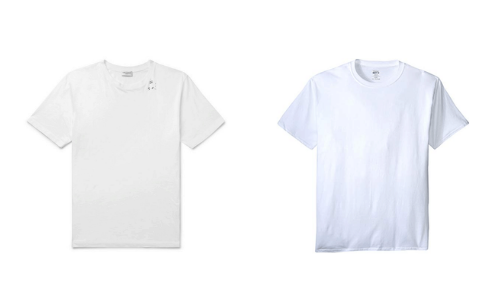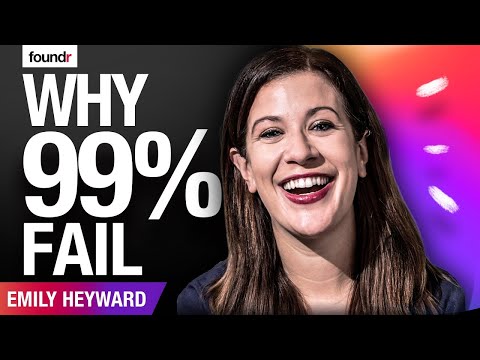What is a positioning statement? Before we get into the nitty-gritty details, let’s review a brand positioning statement example in action. This t-shirt (below left) costs $395.

Yes, this Saint Laurent t-shirt will set you back more than $400 once you add shipping costs into the mix.
Now let’s compare this premium-priced shirt to a $16.99 version from Hanes (above right).
The Saint Laurent shirt is about 25 times more expensive than the one from Hanes. Does that mean it’s 25 times better? Not necessarily.
So how’s it possible to charge hundreds of dollars more for what is ultimately the same type of shirt? The difference can be explained through one of the most underleveraged marketing tools: brand positioning statements. A positioning statement is a simple but refined piece of text that articulates exactly why someone might spend their money on what you have to offer instead of on your competitor’s product (even if they might seem identical).
It’s worth pointing out that just because the Saint Laurent shirt is 25 times more expensive doesn’t mean they’ve built a better business than Hanes. They’ve just deliberately positioned themselves to attract a different type of customer—one who prioritizes luxury and status over convenience. Actually, Hanes is the bigger company.
The point is that both companies succeed because they know who their products are for and what problems they solve for their customers. If you want your products to succeed, you need to make sure you do the same.
We’ll show you exactly how to create a positioning statement for your products and services so you can stand out in the online marketplace where options are plentiful and banner blindness is a constant obstacle to sales. Even more, we’ll give you a glimpse at how positioning your ecommerce product correctly can help you attract dream customers to your business.
Breakdown of a Brand Positioning Statement
In its simplest form, a positioning statement is a single sentence or phrase that clearly explains why your customers would choose your products or services over the alternatives. It’s similar to your unique selling proposition (USP), and while serving as an internal document, your positioning statement strongly influences external communications, especially your slogan or tagline.
Your brand positioning statement is a secret weapon that most people don’t put a lot of thought into. While they might seem like tiny, throwaway phrases, the truth is they come to define who you serve and what problems only you can solve.
For example, take a look at an early way that Domino’s Pizza positioned its business: “Delivered in 30 minutes or it’s free.”
This single phrase did more than just communicate to consumers that if they wanted a pizza fast, they should choose Domino’s. As a business, this value proposition forced them to make choices that prioritize delivery speed over everything else. So Domino’s might not have cared as much about using fresh ingredients or how their stores looked, putting more emphasis on prepackaged ingredients and efficiency.
On the other hand, DiGiorno Pizza relies on a completely different value proposition. They put “It’s not delivery. It’s DiGiorno” everywhere in their marketing.
This tells consumers that if they want a frozen pizza that tastes as good as (or better than) delivery, choose DiGiorno. Notice DiGiorno is appealing to a different segment of the pizza market. Instead of focusing on the speed of delivery, they’re highlighting the quality and taste.
Ultimately, Domino’s and DiGiorno have the same product, but who buys each one and how each business presents their solution couldn’t be more different.
Which brings us to the elements of an effective brand positioning statement template. Your positioning statement needs to include:
- Who the product/service is for
- What problem it solves
- How it’s different than its competition
Bear in mind that these elements are often implied, rather than explicitly stated. So you won’t need to be an advertising genius to come up with catchy, memorable, customer-grabbing positioning statements. In fact, we’re about to give you the 3-step process that anyone can use to write a great positioning statement for their products.

3 Steps to Writing a Great Positioning Statement
Step 1: Articulate How Your Business Is Different from the Competition
Start by making an exhaustive list of all the ways you are different from your competitors. For example, if your product formulation is 10 times better than the rest, write down why that’s important to your customers. If you’re able to extend a guarantee for your customers that your competition is afraid to offer, talk about why you go above and beyond to make such a guarantee. If you have a wealth of experience that none of your competitors can match, list out all the reasons your customers should care about that.
The whole point of this first step is to get down on paper all the ways that you are different from and better than your competition. If you’ve never thought about these things before, spend some time digging in and doing some research on your competition. Once you’ve got an exhaustive list of differentiators, you can move on to the next step.
Step 2: Refine Down to the Essentials
Once you have a comprehensive list of reasons someone should choose you over the competition, it’s time to cut your positioning statement down to something simple and concise. Aim for one sentence, though it’s okay to sometimes extend to 2 or 3 sentences if necessary.
Imagine that you can only say one thing to your dream customer in order to stop them in their tracks and get them interested in what you have to say. With that constraint in mind, think about what differentiating features you’d highlight in order to set the hook. What is the most immediately irresistible thing you could promise to your dream customer?
Step 3: Make Your Dream Customer Say, ‘I Want That!’
A huge part of positioning your ecommerce product is making it clear who you serve. When your dream customer sees your positioning statement, they should immediately say, “I want that!”
Ready for a case study? Hemple is an Australian-based supplement company that sells a variety of hemp-based products, including CBD (cannabidiol) oil and hemp seed protein powder. If you’re a fan of hemp-based products, your ears might have perked up when you read this last sentence. If you’ve never used such products, you might not care at all about Hemple’s offerings.
And that’s what distinguishes an audience. Not everyone is interested in hemp-based products, so instead of using a shotgun approach, Hemple’s positioning is aiming directly at their dream customer. And their research reveals that the best message should focus on the quality and value of their products.
Because of recent changes in laws surrounding how and where hemp products can be sold, a lot of CBD companies have rushed products to market, hoping to gobble up a share of the “green gold rush.” In the process, some are cutting corners when it comes to quality.
Hemple knows this and wants customers to know they’re different. So notice how they position themselves on their website:

For health-conscious consumers who care about the benefits of CBD oil, every word in that phrase communicates extreme value. For example, it’s vital that hemp is organically grown so there aren’t any unwanted pesticides in the oil. Likewise, the oil should be full-spectrum because studies have shown that isolated CBD extracts have limited benefits. Another key is that the hemp oil is extracted with CO2 and not harsh chemicals like butane or hexane.
Not every person who buys CBD oil will know these facts. But for the people who care about using a quality CBD oil, Hemple conveys all those details about their brand in one succinct phrase.
The key to pulling this off for your business is knowing which features are most important to your target customers and putting them front and center.
More Positioning Statement Examples in Action
The best way to learn how to write a great positioning statement is to see effective examples from a variety of industries. We’ve already looked at pizza and hemp-based products. Even without knowing their exact internal positioning statements, we can definitely see from their branding how strong each company’s positioning is.
Let’s now look at how Foundr used compelling positioning for our own Instagram Domination Course. As you’re probably aware, there are plenty of videos and tutorials on building a profitable business with Instagram. But the problem with many of these competing products is that it’s hard to know who you can trust.
With that in mind, a compelling way to position Foundr’s course became clear. The product’s positioning needed to communicate the fact that Foundr’s team knows their stuff when it comes to Instagram. Rather than a fluff course, this is a proven system.
Here’s the tagline for the course:
“Learn the exact system we used to grow our Instagram to one million followers, and the same training used by our students to get followers and make money.”
Foundr is able to leverage the fact that our system helped attract 1 million followers and, more importantly, helped individual students achieve substantial success. That differentiation is key when people are deciding how to learn Instagram growth strategies.
One final positioning statement example comes courtesy of Mint.com. Mint is a free budget tracker that helps customers understand their spending habits. When most people think about managing their finances, they’re overwhelmed by the prospect of complicated spreadsheets and having to manually sort through all their accounts.
Mint understands that these actions seem overwhelming to many consumers. So they position their application as an all-in-one solution for effortlessly managing your finances.
The value proposition is clear. But even more, it’s a guiding philosophy of the application and business. If you use Mint, you’ll see they make the interface easy to use and even easier to understand. They want to put you in control of your finances so you’re in control of your life. And that’s communicated from the moment you visit their site and in the way they build their business and app.
Get Your Brand Positioning Right and Sales Will Follow
Positioning your products is a powerful marketing tool you can’t afford to ignore. As you’ve seen, a correctly positioned product helps guide almost every decision you make in a business.
Yet, many startup businesses plow ahead with their sales and marketing tactics before locking down their brand positioning. The results in these situations will inevitably be simultaneously less efficient and less effective.
When businesses get it right, customers instantly know this is who they must trust and buy from. As a legacy building entrepreneur with great business ideas, you have all the elements required for a strong brand positioning statement. Just gather the details as laid out earlier, distill them into a 1-3 sentence brand positioning template, and you’ll be ready to tell the world what makes you so special.
Of course, your brand positioning is just one of the crucial components of building your brand. Creating an online store that stands out from the crowd, attracts loyal customers, and continually improves its performance takes equal parts expertise and dedication.
Our Start and Scale course, taught by award-winning ecommerce expert Gretta van Riel, features dozens of tips to help you find success. Most importantly, you’ll get the formula Gretta used to launch one of her new brands to $1 million in sales on day one.
The post Brand Positioning Statement Examples That Sell Like Fire appeared first on Foundr.
via https://AiUpNow.com October 15, 2021 at 08:04AM by Grant Olsen, Khareem Sudlow,


